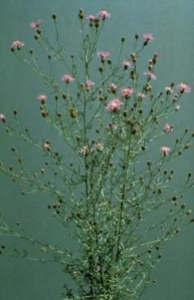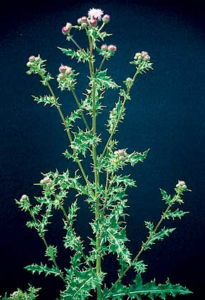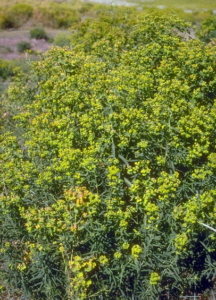Now that the mountain pine beetle is generally under control, it is time to look at some new invaders creeping into The Village at Castle Pines that can devalue our property. Namely, invasive noxious weeds. There are four species that are aggressively invasive to this area and can choke out native vegetation. These culprits are knapweed, thistle, leafy spurge and toadflax. Not only are these weeds prodigious propagators, they are hard to control after they spread. In Colorado, homeowners are required by law to control these noxious weeds on their property.
We recommend you talk to a landscape maintenance professional or certified applicator for spraying options because many of the products used for control of these weeds are regulated and therefore unavailable to most homeowners. If you use a product like Trimec, available at Home Depot and Lowes, please thoroughly read and follow all label instructions, and be very careful around desirable trees and plants.
 Knapweed Quick Facts:
Knapweed Quick Facts:- Knapweed is a creeping perennial that reproduces from seed and vegetative root buds.
- Knapweed emerges in early spring, bolts in May to June, and flowers through the summer into fall
- Russian knapweed is toxic to some animals.
- The key to knapweed control is to stress the weed and cause it to expend nutrient stores in its root system.
- The best management plan includes cultural controls combined with mechanical and/or chemical control techniques.
- The best time to spray is in the spring when knapweed is in the early spring rosette stage of growth. In the fall it should be pulled and bagged before it goes to seed.
 Thistle Quick Facts:
Thistle Quick Facts:- Canadian and Musk are the most common in CPV.
- Canadian thistle is a creeping perennial that reproduces from vegetative buds in its root system and from seed.
- It is difficult to control because its extensive root system allows it to recover from control attempts.
- Combining control methods is the best form of Canada thistle management.
- Persistence is imperative so the weed is continually stressed, forcing it to exhaust root nutrient stores and die.
 Leafy Spurge Quick Facts:
Leafy Spurge Quick Facts:- Leafy spurge (Euphorbia esula L.) is a creeping perennial that reproduces from seed and vegetative root buds.
- It can reduce native plant populations by 50 to 75 percent.
- Leafy spurge is difficult to control. Its extensive root system has vast nutrient stores that let it recover from control attempts.
- Combine control methods into a system to achieve best results.
 Yellow Toadflax Quick Facts:
Yellow Toadflax Quick Facts:- Perennial with stems that grow from one to three feet tall and narrow, linear leaves pointed at both ends.
- A mature plant can produce up to 30,000 seeds annually a single stem has been reported to contain over 5,000 seeds. KEEP this plant from going to seed.
- Seeds can remain dormant in the soil for up to ten years. This plant usually goes to seed in mid-late August.
- Yellow toadflax can reproduce both by seeds and vegetatively. It can aggressively form colonies through adventitious buds from creeping root systems.
- It is somewhat poisonous to some animals.
If you have additional questions please contact one of the CPHA’s Landscape Technicians at 303-814-1345.

